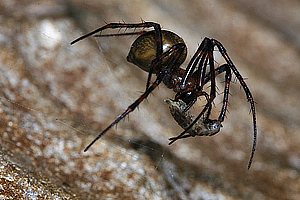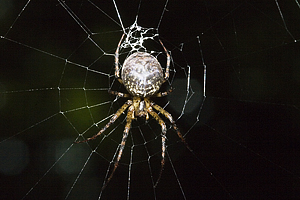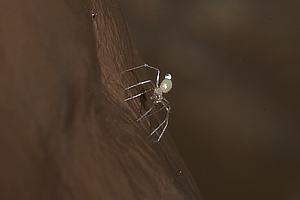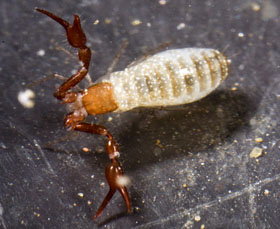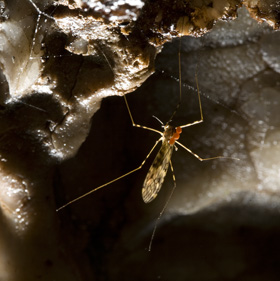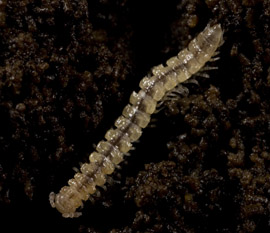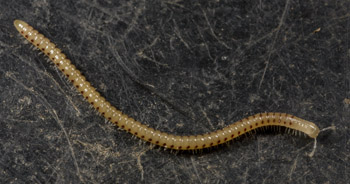 |
Cave Life of Wales |
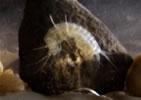 |
| |
| HOME |
| INTRODUCTION |
| LIFE IN THE ENTRANCE |
| LIFE IN THE CAVE |
| CONSERVATION |
| GLOSSARY |
| ACKNOWLEDGEMENTS |
| |
| Bacteria |
| Fungi |
| Plants, Algae & Protozoans |
| Sponges |
| Flatworms |
| Eelworms & Segmented Worms |
| Slugs & Snails |
| Crustacea |
| Insects |
| Spiders & Millipedes |
| Fish & Amphibians |
| Birds |
| Bats |
Life in the cave - Spiders and millipedes |
||||||||||||||
SPIDERS
The female lays a clump of eggs that and spins a silk cocoon around them for protection. You may see these hanging from the ceiling. Metellina (=Meta) merianae is found in the threshold, often at the entrance itself where it spins a larger, finer orb web across the passage to catch creatures flying in and out of the cave. The spider is a similar shape to Meta menardii, but smaller, brown and grey in colour with spots on the legs.
In the cracks by the cave entrance you might see Nesticus cellulanus. It is a smaller, paler spider that builds a fine, criss-cross platform web that is attached to the walls by longer threads that have a sticky 'gum' drop near the base. The Nestiscus web traps crawling and flying insects and in this way it avoids competing for the same food as M. merianae. You may also see sheet webs by the entrance containing silk tunnels. These are made by Tegenaria sp. but the spider is usually well hidden in a crevice behind the web. There a number of 'money spiders' (e.g. Porrhomma sp.) found in caves. P.convexum is common – but there are few records in Wales. In the dark zone of Ogof y Ci you may find Britain’s only troglobitic spider, Porrhomma rosenhaueri. It is a straw coloured blind spider – but it is only 2mm long and probably hiding in a crack so you will have to look carefully to find one. Other 'money spiders' include Lessertia dentichelis and Lepthyphantes pallidus. Porrhomma sp. webs are often in obscure cracks and crevices in the walls of the cave, and the spiders even harder to spot.
All spiders are predatory but they themselves may not have many predators in the cave. Bats do not appear to be interested except possibly Natterer's bat (Myostis natterei) in caves during cold weather or when hibernating. Young spiders (spiderlings) have to shed their skeletons five to ten times (moult or ecdysis) to grow, and often the discarded remains are mistaken for dead spiders. The newly emerged spider is slightly paler for a while. PSEUDOSCORPIONS are small and abundant arthropods but are difficult to spot as they are only 2-4mm in length. They are aggressive hunters and use their enlarged pedipalps to catch prey. Once it has sucked up the contents of its prey it can survive for weeks even months without another meal.
MITES are small relatives of spiders. There are a number of mites found living in Welsh caves and some are probably troglobites. Rhagidia spelaea is relatively common (found in Ogof Ffynnon Ddu and Ogof Clogwyn). Some mites are truly microscopic and go unnoticed. They live in a variety of habitats - some free living, some parasitic on plants and animals, others preying on e.g. Collembola. Eugamasus magnus and E. loricatus have been found in Porth yr Ogof and Eglwys Faen. There should be some water mites to add to the list of mites found in Welsh caves. In Ogof Ffynnon Ddu Rhagidia sp. that prey on Collembola are widespread but infrequent (like many cave creatures).
Parasitic ticks and mites in caves are associated with bats. TICKS The most common tick on bats is Ixodes vespertilionis, the female lives on the blood of the bat and is closely associated with caves. MILLIPEDES and other MYRIAPODA The Pauropoda ‘small feet’ are tiny (1mm), blind creatures similar in shape to centipedes with 9-11 pairs of legs that are generally found in soil feeding on dead plant matter. They look a bit like springtails but if you blow on them they run quickly backwards. They are thought to be scavengers. Although there are no records from Welsh caves there are cave records from elsewhere in the country and they might be found in accumulations of detritus in the threshold zone. The Order Polydesmida (the flat backed millipedes) get their name from the broad extensions to the body armour giving them a flattened appearance. They include Nanogona, Polydesmus, Brachydesmus, and Oxidus and have distinctive flattened bodies with about 20 segments, grow to 20-40 mm long and vary in colour from whitish to brown. Some of these species produce hydrogen cyanide.
Another common caverniculous species is the blind Spotted Snake Millipede Blaniulus guttulatus. The red spots down the sides are stink glands (ozadenes). This millipede may be more common in caves during winter when the colder temperatures encourage the millipede to go deeper into the soil. A similar spotted species, but with eyes, is likely to be Cylindroiulus sp.
Centipedes are normally regarded as soil organisms and there have been few recordings from caves. They are active predators with poison claws feeding on nematodes, mites and other smaller insects. The most common species that might be encountered is Lithobius microps (=L. dubosqui), a small (to 10mm), robust, red-brown, rather short-bodied species with 15 pairs of legs. Immature ones can be hard to identify as features are added as they grow such as antennae segments, teeth etc. It might be regarded as a possible cavernicole although unlike some other centipedes and many of the millipedes found underground this species has ocelli (simple eyes). When disturbed it may curl up like a millipede. After each moult centipedes may have a violet tinge for a few hours.
|
